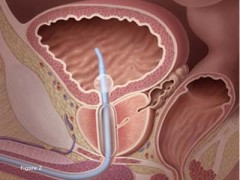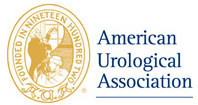
Transurethral Microwave Therapy (TUMT) for Benign Prostatic Hyperplasia
In transurethral microwave therapy (TUMT), an instrument (called an antenna) that sends out microwave energy is inserted through the urethra to a location inside the prostate. Microwave energy is then used to heat the inside of the prostate. Cooling fluid is circulated around the microwave antenna to prevent heat from damaging the wall of the urethra. To prevent the temperature from getting too high outside the prostate, a temperature sensor is inserted into the man's rectum during the procedure. If the temperature in the rectum increases too much, the treatment is turned off automatically until the temperature goes back down.
The temperature becomes high enough inside the prostate to kill some of the tissue. As this part of the prostate heals, it shrinks, reducing the blockage of urine flow.
This treatment is done in a single session. It usually does not require an overnight stay in the hospital. A general or spinal anesthetic maybe needed during the procedure.
Microwave therapy is also known as Prolieve Therapy.
What is Prolieve
The Prolieve System is an in-office technology, a medical device that both heats the prostate and dilates the prostatic urethra. The purpose of the Prolieve System is to treat the symptoms of enlarged prostate (BPH) in men who would benefit from drug or surgical therapy. The treatment was designed with patients' needs and comfort in mind.
To see how the Prolieve System works, view the video
below.
What to Expect During your Prolieve Treatment
- The physician will insert a catheter into your urethra.
- When microwave energy is turned on, it will be transmitted from a special antenna inside the catheter to provide heat to your prostate.
- The heat will reduce the enlarged tissue of your prostate.
- A small balloon that is also part of the catheter will inflate within the section of the urethra close to where the prostate is located.
- During the entire 45-minute procedure, water will be circulating inside the catheter through your urethra.
For your safety, the Prolieve System's computer
monitors the temperature surrounding the treatment area by means of a rectal temperature monitor. If the temperature at the monitor reaches 42ºC, the system will shut off automatically.
The Prolieve System is FDA approved. The System's design and operating protocol were investigated in clinical studies of other men suffering from BPH. The results showed the Prolieve System is safe
and effective.
What To Expect After Surgery
You are able to go home after surgery. You may not be able to urinate and may require catheterization to drain your bladder. For most men, this lasts for a few days or less. You also have to take antibiotics or anti-inflammatory medicines if needed for discomfort.
You can generally return to work 1 to 2 days after treatment. Sexual activity can be resumed 1 to 2 weeks after surgery.
Why It Is Done
TUMT is done to help relieve the symptoms of benign prostatic hyperplasia (BPH). It is an option for men who want more than medicines for treatment of their symptoms.
How Well It Works
Studies note that TUMT is more effective than treatment with the alpha-blocker terazosin when checked 18 months later.
In a summary of very small studies, TUMT did not improve symptoms and urine flow as much as transurethral resection of the prostate (TURP) did. But men seemed equally happy with either surgery.
Risks
The main complication of TUMT is the inability to urinate (urinary retention) for more than a week. This condition is treated by inserting a tube directly through the abdominal wall into the bladder to drain urine (suprapubic catheter). Erection problems and retrograde ejaculation (ejaculation backward into the bladder) appear to be less common after TUMT than after TURP.
Other complications include persistent irritation of the urethra and blood in the urine.
Citations:
1. Webber R (2006). Benign prostatic hyperplasia, search date May 2005. Online version of BMJ Clinical Evidence. Also available online: http://www.clinicalevidence.com.











